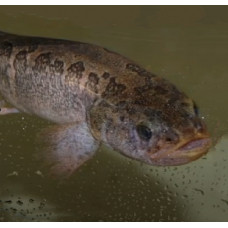Latin name
Dallia pectoralis
Other name
Dallia pectoralis
Identification
The Alaska blackfish can be identified by its short, flattened snout, the posterior position of the dorsal and anal fins, the presence of about 33 rays on the pectoral muscles, and the pelvic fin, which has only 3 rays. The gill rays are short. Lateral line with fine pores, 76 to 100 scales in mid-lateral rows, rudimentary, scales small, embedded in skin. Palpal vertebrae: 40-42. Uses its oesophagus as an auxiliary respiratory organ.
Features of fish fins
The dorsal and anal fins are shifted to the caudal part of the body. The dorsal fin has 10-16 soft rays and the anal fin has 11-16 soft rays. The pectoral fins are very large with 30-38 rays and the pelvic fins have three rays. The caudal fin is rounded.
Fish colouring
The body of this species is blackish brown. The dorsal, caudal and anal fins are bordered by a thin orange stripe which turns red during spawning. Males are lighter and larger than females.
Distribution
Widespread in the waters of Chukotka and also in Alaska. North America: Alaska from the Colville River delta south to the central part of the Alaska Peninsula near Chignik; upstream of the Yukon-Tanana River to Fairbanks. Also the islands of the Bering Sea and north-eastern Siberia, Russia.
Habitat
Boreal freshwater bottom-dwelling species. Found in small rivers, lakes and marshes. Known for their resistance to cold water: they can withstand temperatures as low as -20°C.
Size
These fish reach 33 cm in length, usually around 11 cm. The maximum body weight is 366 g. The maximum reported age is 8 years.
Behavior
Facultative air breather. Usually found in swamps and ponds with dense vegetation, sometimes in medium to large rivers and lakes with abundant vegetation. Migrations appear to be limited to movements to riparian areas or upstream to spawning grounds in spring and (presumably) return migrations to deeper waters in autumn. Alaska blackfish burrow in mud and often freeze in ice for the winter, remaining alive for long periods, but still dying in significant numbers.
Food and feeding habits
Feeds mainly on aquatic invertebrates. The main diet consists of seed shrimp, water fleas and larvae of flies. Gastropods, paddlefish, caddisfly larvae, worms and algae are also found in their stomachs. In the rivers of Bristol Bay, juvenile conspecifics and pike play an important role in the diet of large dallies.
Reproduction
Laying eggs, spawning in groups. In Chukotka they first mature at the age of 3-4 years with a body length of 6-7 cm, in Alaska females reach maturity at a length of 80 mm. They spawn from May to August. During the spawning season, females lay several portions of eggs at regular intervals. Fecundity varies from 40 to 300 eggs, depending on the size of the female. The eggs are sticky and adhere to aquatic vegetation. The incubation period at 12°C is 5 days. The length of the hatched larvae is 6 mm. The yolk sac is resorbed after about 10 days.
Fishing
This species is of no commercial interest to fisheries.
Relationship with a person
Harmless.
| Classification | |
| Phylum | Chordata |
| Class | Actinopterygii |
| Squad | Esociformes |
| Family | Esocidae |
| Genus | Dallia |
| Species | D. pectoralis |
| Features | |
| Conservation status | Secure |
| Habitat | Bottom |
| Life span, years | 8 |
| Maximum body weight, kg | 0,366 |
| Maximum length, cm | 33 |
| Sailing speed, m/s | No information |
| Threat to people | Edible |
| Way of eating | Bentophage |
Alaska blackfish
Tags: alaska blackfish


